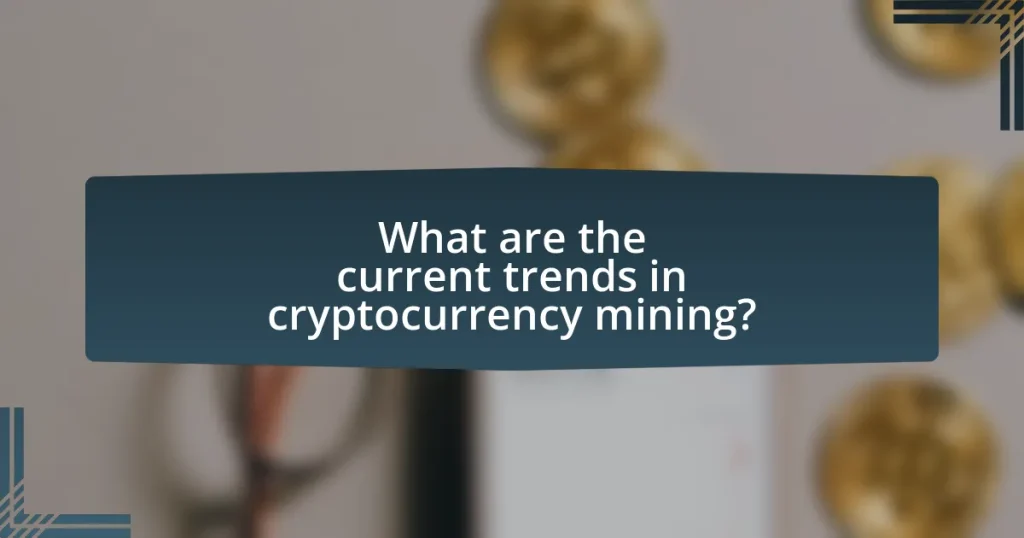The article focuses on current trends in cryptocurrency mining, emphasizing the shift towards sustainability and profitability. It highlights the increasing adoption of renewable energy sources, such as solar and wind, driven by rising energy costs and environmental concerns, with reports indicating that a significant portion of Bitcoin mining is now powered by renewables. Additionally, advancements in mining hardware, particularly ASIC miners, are improving energy efficiency and profitability. The article also discusses the impact of regulatory changes on mining operations, the environmental implications of traditional mining practices, and strategies for miners to optimize their operations while balancing sustainability and profitability.

What are the current trends in cryptocurrency mining?
Current trends in cryptocurrency mining include a significant shift towards sustainability and energy efficiency. Miners are increasingly adopting renewable energy sources, such as solar and wind, to power their operations, driven by rising energy costs and environmental concerns. For instance, a report from the Cambridge Centre for Alternative Finance indicates that 39% of Bitcoin mining is powered by renewable energy, highlighting the industry’s move towards greener practices. Additionally, advancements in mining hardware are enhancing profitability by improving energy consumption rates, with newer ASIC miners offering higher hash rates while using less power. This trend reflects a broader industry focus on balancing profitability with environmental responsibility.
How is the landscape of cryptocurrency mining evolving?
The landscape of cryptocurrency mining is evolving towards increased sustainability and efficiency. This shift is driven by rising energy costs, regulatory pressures, and growing environmental concerns, prompting miners to adopt renewable energy sources and more efficient mining hardware. For instance, a report from the Cambridge Centre for Alternative Finance indicates that as of 2021, 56% of Bitcoin mining was powered by renewable energy, highlighting a significant trend towards greener practices. Additionally, advancements in mining technology, such as the development of ASIC miners with higher hash rates and lower energy consumption, are further enhancing profitability while reducing the carbon footprint of mining operations.
What technological advancements are influencing cryptocurrency mining?
Technological advancements influencing cryptocurrency mining include the development of more efficient hardware, such as ASIC miners, and the implementation of renewable energy sources. ASIC miners, specifically designed for cryptocurrency mining, offer significantly higher hash rates and energy efficiency compared to traditional GPUs, leading to reduced operational costs. Additionally, the integration of renewable energy solutions, like solar and wind power, is becoming increasingly popular, as it lowers carbon footprints and enhances sustainability in mining operations. According to a report by the Cambridge Centre for Alternative Finance, as of 2021, around 39% of Bitcoin mining was powered by renewable energy, showcasing a trend towards more sustainable practices in the industry.
How are regulatory changes impacting cryptocurrency mining trends?
Regulatory changes are significantly impacting cryptocurrency mining trends by influencing operational costs and location choices for miners. For instance, stricter regulations in regions like China have led to a mass exodus of miners to countries with more favorable policies, such as the United States and Canada, where energy costs and regulatory environments are more conducive to mining activities. According to the Cambridge Centre for Alternative Finance, as of 2021, the U.S. accounted for approximately 35% of global Bitcoin mining, reflecting a shift driven by regulatory factors. Additionally, regulations aimed at promoting sustainability are pushing miners to adopt greener technologies, as seen in the increasing investment in renewable energy sources for mining operations.
What role does sustainability play in cryptocurrency mining?
Sustainability plays a critical role in cryptocurrency mining by addressing the environmental impact associated with high energy consumption. Cryptocurrency mining, particularly for coins like Bitcoin, requires substantial computational power, leading to significant electricity usage, which often relies on fossil fuels. According to the Cambridge Centre for Alternative Finance, Bitcoin mining consumes approximately 100 terawatt-hours of electricity annually, comparable to the energy consumption of some small countries.
To mitigate these effects, many mining operations are shifting towards renewable energy sources, such as solar, wind, and hydroelectric power. This transition not only reduces carbon emissions but also enhances the long-term viability of mining operations by stabilizing energy costs. Furthermore, sustainable practices in mining can improve public perception and regulatory acceptance, which are increasingly important as environmental concerns grow globally.
Why is sustainability becoming a priority in cryptocurrency mining?
Sustainability is becoming a priority in cryptocurrency mining due to the significant environmental impact associated with high energy consumption and carbon emissions. The Bitcoin network, for example, consumes approximately 130 terawatt-hours of electricity annually, which is comparable to the energy usage of entire countries. As regulatory scrutiny increases and public awareness of climate change grows, miners are pressured to adopt greener practices. Additionally, the shift towards renewable energy sources, such as solar and wind, is being driven by both economic incentives and the need to reduce the carbon footprint of mining operations. This transition not only addresses environmental concerns but also enhances the long-term viability and public perception of cryptocurrencies.
What are the environmental impacts of traditional cryptocurrency mining?
Traditional cryptocurrency mining has significant environmental impacts primarily due to its high energy consumption and carbon emissions. The process of mining, particularly for cryptocurrencies like Bitcoin, requires substantial computational power, which translates to large amounts of electricity. For instance, the Cambridge Centre for Alternative Finance reported that Bitcoin mining consumes approximately 130 terawatt-hours of electricity annually, comparable to the energy usage of entire countries like Argentina.
This energy demand often relies on fossil fuels, leading to increased greenhouse gas emissions. A study published in the journal Nature Communications found that Bitcoin mining alone could contribute to a rise in global temperatures by 2 degrees Celsius if it continues at its current pace. Additionally, the mining operations can lead to habitat destruction and water pollution due to the physical infrastructure required and the e-waste generated from outdated mining equipment.
How does profitability factor into cryptocurrency mining trends?
Profitability significantly influences cryptocurrency mining trends by determining the viability of mining operations. As the price of cryptocurrencies fluctuates, miners assess their potential returns against operational costs, including electricity and hardware expenses. For instance, when Bitcoin’s price surged to nearly $64,000 in April 2021, many miners expanded their operations due to increased profitability, leading to higher network hash rates. Conversely, during price downturns, such as the drop to around $30,000 in mid-2021, many miners faced reduced profitability, prompting some to halt operations or sell off equipment. This cyclical relationship between profitability and mining activity shapes the overall landscape of the cryptocurrency mining industry.
What are the key factors affecting profitability in cryptocurrency mining?
The key factors affecting profitability in cryptocurrency mining include electricity costs, hardware efficiency, cryptocurrency market prices, and mining difficulty. Electricity costs represent a significant portion of operational expenses, with rates varying widely by location; for instance, miners in regions with lower electricity prices can achieve higher profitability. Hardware efficiency, measured in hash rate per watt, directly impacts the amount of cryptocurrency mined relative to energy consumed, making advanced mining rigs more profitable. Additionally, the market prices of cryptocurrencies fluctuate, influencing revenue; for example, a surge in Bitcoin’s price can dramatically enhance profitability. Lastly, mining difficulty adjusts based on network activity, affecting the likelihood of successfully mining blocks; as difficulty increases, profitability can decrease if miners do not upgrade their equipment or optimize their operations.
How do market fluctuations influence mining profitability?
Market fluctuations significantly influence mining profitability by directly affecting the price of cryptocurrencies, which in turn impacts miners’ revenue. When cryptocurrency prices rise, mining becomes more profitable as miners earn more from their mined coins; for instance, Bitcoin’s price surged from around $3,000 in 2018 to over $60,000 in 2021, leading to increased mining activity and profitability. Conversely, when prices fall, such as Bitcoin dropping below $4,000 in early 2020, many miners may face losses, leading to reduced mining operations or even shutdowns. Additionally, fluctuations can affect the difficulty of mining, as more miners enter the market during price increases, making it harder to mine profitably. Thus, the relationship between market prices and mining profitability is dynamic and closely intertwined.

What are the challenges faced in cryptocurrency mining?
Cryptocurrency mining faces several significant challenges, including high energy consumption, regulatory scrutiny, and hardware costs. High energy consumption is a critical issue, as mining operations often require substantial electricity, leading to increased operational costs and environmental concerns. For instance, the Cambridge Centre for Alternative Finance reported that Bitcoin mining consumes approximately 0.5% of the world’s electricity. Regulatory scrutiny is another challenge, as governments worldwide are increasingly implementing regulations that can impact mining operations, such as bans or restrictions on energy use. Additionally, the cost of specialized hardware, such as ASIC miners, can be prohibitively high, making it difficult for new miners to enter the market. These challenges collectively affect the sustainability and profitability of cryptocurrency mining.
How do energy consumption and costs affect mining operations?
Energy consumption and costs significantly impact mining operations by influencing profitability and operational efficiency. High energy consumption leads to increased operational costs, which can erode profit margins, especially in cryptocurrency mining where profit is closely tied to the price of the mined asset. For instance, in 2021, Bitcoin mining was estimated to consume around 97 TWh annually, making energy costs a critical factor for miners. Additionally, fluctuations in energy prices can directly affect the viability of mining operations; when energy prices rise, less efficient miners may be forced to shut down, consolidating the market among those who can manage costs effectively. Thus, energy consumption and costs are pivotal in determining the sustainability and profitability of mining operations.
What strategies can miners use to reduce energy consumption?
Miners can reduce energy consumption by implementing more energy-efficient hardware, optimizing mining algorithms, and utilizing renewable energy sources. Energy-efficient hardware, such as ASIC miners, consumes significantly less power compared to older models, leading to lower energy costs. Additionally, optimizing mining algorithms can enhance performance while reducing the computational power required, thus conserving energy. Furthermore, transitioning to renewable energy sources, like solar or wind power, can drastically decrease reliance on fossil fuels, which are often more energy-intensive. For instance, a study by the Cambridge Centre for Alternative Finance indicates that miners using renewable energy can reduce their carbon footprint by up to 75%.
How do energy prices impact the profitability of mining?
Energy prices significantly impact the profitability of mining by directly influencing operational costs. Higher energy prices increase the expenses associated with powering mining rigs, which can erode profit margins. For instance, in 2021, energy costs accounted for approximately 60% of total mining expenses, highlighting the critical role of energy prices in determining profitability. Conversely, lower energy prices can enhance profitability by reducing overall operational costs, allowing miners to retain a larger share of their earnings. Thus, fluctuations in energy prices can lead to substantial variations in the financial viability of mining operations.
What are the risks associated with cryptocurrency mining?
The risks associated with cryptocurrency mining include financial loss, regulatory uncertainty, environmental impact, and security vulnerabilities. Financial loss can occur due to the high costs of hardware, electricity, and potential fluctuations in cryptocurrency prices, which can lead to unprofitable operations. Regulatory uncertainty arises as governments worldwide are still developing frameworks for cryptocurrency, which can result in sudden changes in legality or taxation that affect miners. The environmental impact is significant, as mining consumes large amounts of energy, contributing to carbon emissions and raising concerns about sustainability. Lastly, security vulnerabilities exist, as miners face risks from hacking, malware, and potential theft of mined coins or mining equipment. These factors collectively highlight the multifaceted risks involved in cryptocurrency mining.
How does market volatility pose risks to miners?
Market volatility poses significant risks to miners by affecting the profitability of their operations. When cryptocurrency prices fluctuate dramatically, miners may find that the costs of electricity, hardware, and maintenance exceed the revenue generated from mining rewards. For instance, during periods of sharp price declines, the value of mined coins can drop below the operational costs, leading to financial losses. Historical data shows that in 2018, Bitcoin’s price fell from nearly $20,000 to around $3,000, causing many miners to shut down due to unprofitability. This volatility can also lead to uncertainty in investment decisions, making it challenging for miners to plan for future expansions or upgrades.
What security threats do cryptocurrency miners face?
Cryptocurrency miners face several security threats, including hacking, malware attacks, and physical theft. Hacking incidents can lead to unauthorized access to mining pools or wallets, resulting in significant financial losses; for instance, the 2018 Coincheck hack resulted in the theft of $530 million worth of NEM tokens. Malware attacks, such as cryptojacking, can compromise miners’ systems, allowing attackers to hijack computing power for their own mining activities. Additionally, physical theft of mining hardware poses a risk, as valuable equipment can be targeted for robbery. These threats highlight the vulnerabilities inherent in cryptocurrency mining operations.

What are the best practices for sustainable and profitable cryptocurrency mining?
The best practices for sustainable and profitable cryptocurrency mining include utilizing renewable energy sources, optimizing hardware efficiency, and implementing effective cooling solutions. Renewable energy, such as solar or wind, significantly reduces carbon footprints and operational costs, as evidenced by a study from the Cambridge Centre for Alternative Finance, which highlights that regions using renewable energy for mining can achieve lower electricity costs. Optimizing hardware efficiency involves selecting energy-efficient mining rigs and regularly updating software to enhance performance, which can lead to increased profitability. Effective cooling solutions, such as immersion cooling, not only prolong the lifespan of mining equipment but also reduce energy consumption, further contributing to sustainability and profitability.
How can miners balance sustainability and profitability?
Miners can balance sustainability and profitability by adopting renewable energy sources and optimizing mining operations for energy efficiency. Utilizing solar, wind, or hydroelectric power reduces reliance on fossil fuels, which lowers carbon emissions and operational costs. For instance, a study by the International Energy Agency indicates that transitioning to renewable energy can decrease electricity costs by up to 30% in some regions. Additionally, implementing advanced cooling technologies and energy-efficient hardware can further enhance profitability while minimizing environmental impact.
What technologies can enhance both sustainability and profitability in mining?
Technologies that can enhance both sustainability and profitability in mining include advanced data analytics, renewable energy integration, and automation. Advanced data analytics allows for optimized resource extraction and reduced waste, leading to cost savings and lower environmental impact. Renewable energy integration, such as solar or wind power, can significantly reduce operational costs and carbon emissions, making mining operations more sustainable. Automation technologies, including autonomous vehicles and robotic systems, improve efficiency and safety while minimizing labor costs and environmental disturbances. These technologies collectively contribute to a more sustainable and profitable mining sector by reducing costs, enhancing operational efficiency, and lowering environmental footprints.
What are the most effective strategies for optimizing mining operations?
The most effective strategies for optimizing mining operations include implementing advanced hardware, utilizing renewable energy sources, and employing efficient cooling systems. Advanced hardware, such as ASIC miners, significantly increases hash rates and reduces energy consumption per unit of output. Utilizing renewable energy sources, like solar or wind, lowers operational costs and enhances sustainability, as evidenced by studies showing that renewable energy can reduce mining costs by up to 50%. Efficient cooling systems, such as immersion cooling, improve equipment longevity and performance, leading to higher overall productivity. These strategies collectively enhance profitability while promoting sustainable practices in cryptocurrency mining.
What resources are available for miners looking to improve their practices?
Miners looking to improve their practices can access various resources, including industry guidelines, educational programs, and technological tools. The International Energy Agency (IEA) provides reports on energy efficiency in mining, which can help miners adopt sustainable practices. Additionally, organizations like the Blockchain Research Institute offer research and insights into best practices for cryptocurrency mining. Online platforms such as Coursera and Udemy provide courses on energy-efficient mining techniques and blockchain technology, enabling miners to enhance their knowledge and skills. Furthermore, mining hardware manufacturers often publish optimization guides that detail how to maximize efficiency and reduce energy consumption.
How can miners stay informed about the latest trends and technologies?
Miners can stay informed about the latest trends and technologies by actively engaging with industry publications, attending conferences, and participating in online forums. Industry publications such as CoinDesk and Bitcoin Magazine provide regular updates on technological advancements and market trends. Conferences like Consensus and Mining Disrupt offer networking opportunities and insights from experts. Online forums and communities, such as Reddit and specialized Discord channels, facilitate discussions and knowledge sharing among miners. These resources collectively ensure that miners remain updated on innovations that can enhance sustainability and profitability in cryptocurrency mining.
What communities or networks can support miners in their efforts?
Cryptocurrency miners can find support through various communities and networks such as mining pools, online forums, and social media groups. Mining pools like Slush Pool and F2Pool allow miners to combine their resources, increasing the chances of earning rewards collectively. Online forums such as BitcoinTalk and Reddit’s r/BitcoinMining provide platforms for sharing knowledge, troubleshooting issues, and discussing best practices. Additionally, social media groups on platforms like Telegram and Discord facilitate real-time communication and collaboration among miners, fostering a sense of community and shared learning. These networks enhance miners’ efforts by providing resources, information, and collective strength in navigating the challenges of cryptocurrency mining.










